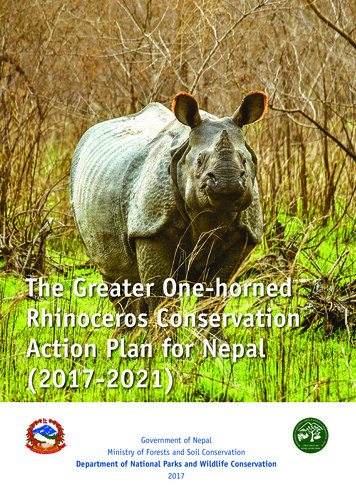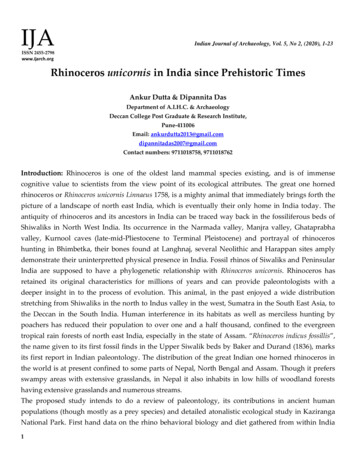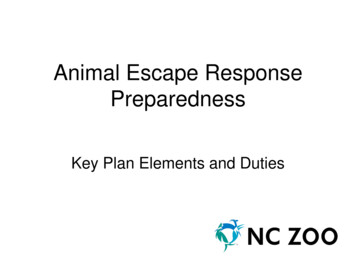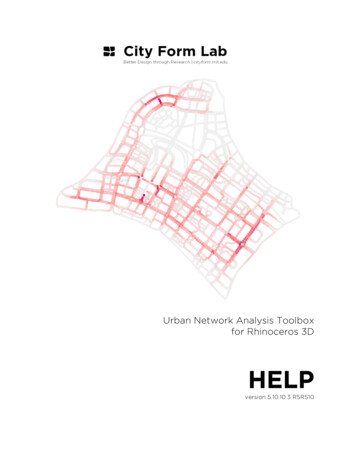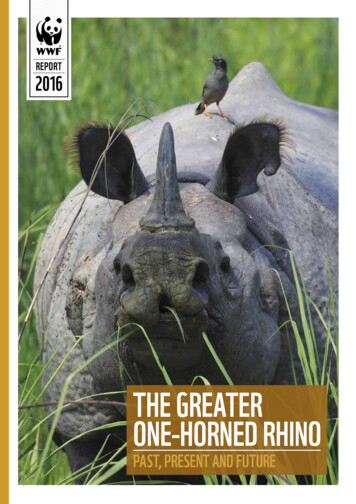
Transcription
REPORT2016THE GREATERONE-HORNED RHINOPAST, PRESENT AND FUTURE
This report is dedicated to the rangers, forest guards,forest officers, the governments of Nepal, Indiaand Bhutan and all those who have helped bring thegreater one-horned rhino back from the brink.Written by: Kees Rookmaaker (Rhino Resource Centre),Amit Sharma, Joydeep Bose, Kanchan Thapa,Barney Jeffries, Christy Williams, Dipankar Ghose,Mudit Gupta and Sami Tornikoski.Designed by Lou ClementsPublished in May 2016 by WWF – World WideFund for Nature (Formerly World Wildlife Fund),Gland, Switzerland (“WWF”). Any reproduction infull or in part must credit the above mentioned publisheras the copyright owner.Suggested citation: Rookmaaker, K., Sharma, A.,Bose, J., Thapa, K., Dutta, D., Jeffries, B., Williams,A.C., Ghose, D., Gupta, M. and S. Tornikoski. 2016.The Greater One-Horned Rhino: Past, Presentand Future. WWF, Gland, Switzerland. 2016 WWF. All rights reserved.About WWFWWF is one of the world’s largest and mostexperienced independent conservation organizations,with over 5 million supporters and a global networkactive in more than 100 countries.WWF’s mission is to stop the degradation of theplanet’s natural environment and to build a futurein which humans live in harmony with nature, byconserving the world’s biological diversity, ensuringthat the use of renewable natural resources issustainable, and promoting the reduction ofpollution and wasteful consumption.
CONTENTSForeword5Introduction7Sacred symbol to conservation icon10The rhino’s range: then and now12Back from the brink14Today’s threats17Conservation efforts20Rhinos and people28The future32
FOREWORDThis report is a comprehensive document onthe greater one-horned rhinoceros, puttogether by a team of expert scientists andconservationists. The report not only addressesthe present status and distribution of this species, butalso elaborates conservation actions that are necessaryto secure its future. We believe it will help and guidethe researchers, managers and people working for theconservation of this species in the years to come.WHAT THE RHINOTEACHES US ISRESILIENCE. WEBELIEVE THISICONIC SPECIESCAN CONTINUEITS REMARKABLERECOVERYIn India, WWF has been associated with conservation of rhinos for the past threedecades, and we are committed to securing the long-term future of the greater onehorned rhinoceros in the country. Our rhino conservation activities include securingits present populations and habitats and expanding its range. Over the last 10 years,we have intensified our efforts through the Indian Rhino Vision 2020 programmein Assam, which has helped to significantly increase the rhino population andreintroduce rhinos into areas from which they had been lost. The rhino population inAssam now stands at 2,626, and there are also healthy populations in WestBengal and Uttar Pradesh.When WWF started work in Nepal way back in the 1960s, rhinos were the centrepieceof our conservation efforts. Rhinos were on the verge of extinction, reduced to nearly100 individuals from more than 800 in the early 1950s. It is a matter of pride for usto see how our work with the government and local communities has gained strength,as seen in the remarkable recovery of this iconic species in Nepal.As per the 2015 rhino count data, there are now 645 rhinos in Nepal – the highestnumber recorded to date – distributed across four protected areas in the Terai ArcLandscape. This marks an increase of 111 rhinos compared to the last count made in2011. This is indeed a historic success for a nation that had lost 37 rhinos to poachingalone in a single year in 2002. Thanks to the efforts of front-line protection staff,local communities and conservation partners, Nepal recently observed another 365days of zero poaching of rhinos – for a fourth time since the first success in 2011.There are opportunities, too, to provide refuge for rhinos in Bhutan, particularlyin the Royal Manas National Park, which adjoins Manas National Park in Assam,where rhinos have been successfully reintroduced. WWF-Bhutan has a strong trackrecord of working with the government and local people on wildlife conservationand sustainable development in the Himalayan kingdom.What the rhino teaches us, as true to its character, is resilience. With the leadershipof government, the support of conservation partners such as WWF, and thecommitted on-the-ground efforts of enforcement agencies and local communities,we believe this iconic species can continue its remarkable recovery.Dechen Dorji,Country Representative,WWF-BhutanThe greater one-horned rhino 4Anil Manandhar,Country Representative,WWF-NepalRavi Singh,CEO & Secretary General,WWF-India
IN MEMORIAMWe remember all the brave people who have given their lives in the callof duty to protect rhinos: the survival of the species is their legacy.Boluram DuttaMotiram BaruahDharma Kt. KalitaDeben ChasaNiren SaikiaPradip DuttaGopal BoriBabul BaruaRajen HazarikaKanbap DuttaRanjit MedhiChandra Dhar DekaAtul BoraDilip BoraSibian HemromMohendra KarmakarBhupen PaulBimal SaikiaBharat GogoiNitul DuttaKaruna Kanta DasBharat Chandra DasSuchandra MahantaDurjoy BawriKalyan Giri AdhikaryDibyajyoti BordoloiKumud SaikiyaSing SingnerDipen BaruahBhudev ChakrabartyHassen AliDebiram DekaWahed AliLoknath KhatoniarBadan BodoSushil SilJoyotish ChandraChandra DekaAlexhus MundaGhanashyam ThakuriaBhakharu BoroMahendra DasMunin NarzariBircha OrangMatin KhanSerajul IslamSarat Chandra PathakKhagendra ChandraKalitaAjoy TalukdarChabin BoroBariqul IslamDebeswar TalukdarKandura RavaLaskhan BoroLal Bahadur KunwarTika Ram PantChotaki TharuSheshchandra ChaudharyBishnumani KharelKul Bahadur ThapaRamji DhitalBijaya AdhikariRameshower PanditDal Bahadur RaiLaxman BoteKiran ShresthaPahuna TharuGyanraj PuriPrithvi PaweKhadga Bahadur LohaniRamayodhi ChaudharyJugeshower MahattoShreerang KandelBuddhi BoteMadhusudhan NepalJaya Bahadur ChaudharyDhodhai MirdahaPurna Raut AhirBhim Bahadur BhujelTarak Bahadur ThapaGyani ShahaJung Bahadur ShresthaBishnu MahattoJuthiram BoteRam Prasad ChaudharyGonilal ChaudharyThe greater one-horned rhino 5
A. Christy Williams / WWF3,500 200ESTIMATEDPOPULATIONTODAYGREATER ONEHORNED RHINOPOPULATIONIN 1900 4,000POPULATIONWE WANT TOSEE BY 2020
INTRODUCTION3,500TODAY THEREARE AROUND3,500 GREATERONE-HORNEDRHINOS INTHE WILDFrom ancient civilizations to the presentday, the greater one-horned rhinoceros hasbeen an icon of South Asia. Magnificent,enormous, unmistakeable, it’s a source ofwonder, of pride and of tourist revenue.Greater one-horned or Indian rhinos used to be widely spread across vast areasof the northern part of the Indian subcontinent. But centuries of hunting and habitatdestruction brought them to the brink of extinction. By the early 20th century, only200 remained.People realized what was happening just in time. The fight to save the greater onehorned rhino has become one of the great conservation success stories. Today thereare around 3,500 greater one-horned rhinos in the wild. And while they still facesignificant threats from poaching and habitat loss, rhinos are being reintroduced intonew areas and population numbers are still growing.In a world where we are perennially on the back foot trying desperately to slowdown the rate of biodiversity loss, the experience of rhino conservation in Indiaand Nepal shows that it’s possible to recover lost ground and expand large mammalpopulations. What is needed is a clear vision, strong partnerships, adequate funding– and a lot of determination.We now have a historic opportunity to build on these successes. WWF’s vision is tobring rhino populations up to sustainable levels, to reintroduce them to areas wherethey have disappeared, and ultimately to restore rhinos to their historical range. Ourfirst goal is to increase the greater one-horned rhino population in India, Nepal andBhutan to at least 4,000 by 2020. We hope eventually to see the species removedfrom the IUCN Red List of threatened species as its long-term future is secured. Suchan achievement would not only ensure that these remarkable animals will continue toamaze and inspire future generations: it could also provide significant benefits for thecommunities that live alongside rhinos, and provide a focus for wider conservationand sustainable development opportunities.This publication looks at the past, present and future of the greater one-hornedrhino: the rich heritage we so nearly lost, the hard-won lessons and successes, thechallenges we still face, and what we stand to gain.OUR FIRST GOAL IS TO INCREASE THE GREATERONE-HORNED RHINO POPULATION IN INDIA, NEPAL ANDBHUTAN TO AT LEAST 4,000 BY 2020.The greater one-horned rhino 7
The greater one-horned rhino 8
The greater one-horned rhino isone of the few large mammals whosepopulation and range is growing.The outlook for this iconic speciesis brighter today than it has beenfor more than a century. But manychallenges remain in order tosecure its long-term future.On the following pages, we look athow we reached this point – andwhere we go next. A. Christy Williams / WWFRHINOS REBORN
SACRED SYMBOL TOCONSERVATION ICONFrom the earliest civilizationsthrough to the present day, fewanimals have captured the humanimagination like the greaterone-horned rhino.ARCHAEOLOGYArchaeologists have found many representations of the rhino in ancient cultures,ranging across the subcontinent. It appears on seals, pottery, masks and copper tabletsdating back to the Harappan civilization which flourished in the Indus Valley as far eastas Afghanistan from 2,600 to 1,900 BC. Further south in India excavations haveunearthed rhinoceros artefacts in several early Bronze Age sites.In Madhya Pradesh, India, cave paintings showing men with spears hunting rhinocerosdate back hundreds or perhaps even thousands of years. Gupta empire coins minted inthe 5th century show the king on horseback attacking a rhino – a tradition continueda thousand years later by the Mughal emperors, frequently depicted in beautifulilluminated manuscripts.Mughal emperor rhino hunting, from the Babur Nama (16th century) John PavelkaRELIGIONThe rhino is a creature of great symbolic importance in religious contexts. It appears inHindu, Buddhist and Jain sacred scriptures; the mighty Ganges itself was sometimesrepresented as “an old man of an austere aspect, crowned with palms, and pouringwater out of a vase, with a rhinoceros by his side”. The ancient Hindu Vishnu Puranamentions that rhinoceros flesh gives eternal satisfaction to those worshipped at ancestralceremonies, while the horn of the animal consumes all sins. Ritual sacrifices took placefor many centuries.In Nepal, it became customary for rulers to kill a male rhino once in their career and tomake an offering of the animal's blood to the ancestors and pray for peace and prosperity.This ceremony – referred to as “Blood Tarpan” – last took place as recently as 1979.Rhino statues on Siddhi Lakshmi temple, BhaktapurRHINOS IN CAPTIVITYRhinos in some areas were once common enough to be caught and semi-domesticated,sometimes even being used in place of buffaloes to plough fields. It was not uncommonduring the 18th century for rich merchants to keep a rhinoceros in their gardens, whilethe Nawabs of Lucknow kept extravagant menageries including as many as ten or morerhinos. Numerous 19th century records exist too of rhinos being made to fight for theentertainment of the ruling classes.Rhinoceros fight in Baroda, 1875 during the visit of the Prince of Wales(Illustrated London News)The greater one-horned rhino 10
Sacred symbol to conservation icon Jeff Foott / WWFAbove: a coloured copy ofDürer’s famous woodcut,which shaped the imageof the rhino in Europe forhundreds of years.ARTThe first rhino ever seen in Europe was sent from India to the king of Portugal in1515, and later offered as a gift to Pope Leo X. Sadly, the animal died in a shipwreckon the way to Rome – but not before it had been immortalized in a woodcut by thegreat German artist Albrecht Dürer of Nuremberg. Dürer – who never saw the rhinofirst-hand – depicted a great armour-clad beast which, curiously, had a large hornon the nose as well as a small hornlet pointing forwards in the shoulder region. Thisimage appeared in all the books in which a rhino was depicted, well into the 18thcentury, meaning that for at least 300 years the rhinoceros as imagined by Dürerdefined the popular European image of the species.Flagship speciesThe rhino remains one of the world’s most charismatic animals. It’s the state animalof Assam, where three-quarters of greater one-horned rhinos live. For WWF, it’s aflagship species – one of a handful of iconic animals that provide a focus for raisingawareness and stimulating action and funding for broader conservation efforts, suchas protecting important grassland ecosystems. This flagship role, and the rhino’stourism appeal, also provides opportunities for governments and communities.The greater one-horned rhino 11
PA K I S TA Historical DistributionCurrent DistributionPotential HabitatMap based on data from Nico van Strien; developed by IGCMC, WWF-IndiaINDIARhino numbers by protected areaKaziranga National ParkKaterniaghat Wildlife Sanctuary2Jaldapara National Park200Gorumara National Park50Pobitora Wildlife Sanctuary92Orang National Park100Manas National Park32Dudhwa National Park32Chitwan National Park605Bardia National Park29Suklaphanta Wildlife Reserve8Parsa Wildlife Reserve3* Figures as of October 2015The greater one-horned rhino 122,401
THE RHINO’S RANGE:THEN AND NOWThe greater one-horned rhinowas once found right across thenorthern floodplains and foothillsof the Indian sub-continent.It occupied an area stretching from the bordersof Myanmar in the east, across northern Indiaand southern Nepal, as far as the Indus Valley in Pakistan in the west. The northernboundary of its range was the Himalayas, while it was recorded in the south acrossthe plains of the Ganges in West Bengal, into Bihar and Madhya Pradesh, possiblyranging as far as Rajasthan, India.Over the last few centuries this range has been reduced to just 11 pockets of protectedpopulations in northern India and the Nepalese Terai, with the two main hubsbeing Assam’s Kaziranga National Park and Nepal’s Chitwan National Park. Rhinoswere sometimes seen in Royal Manas National Park in Bhutan before the residentpopulation in Manas National Park on the Indian side was exterminated during civilunrest in the region in the 1990s. Rhinos are now making a comeback in Manasthrough a range expansion programme. In Pakistan, rhinos are extinct in the wild.ChitwanD’EringB H U TA aporiBANGLADESHThe historic distributionof greater one-hornedrhinos, their currenthabitat, and potentialsites for reintroduction.The greater one-horned rhino 13
BACK FROMTHE BRINKHunting and habitat destruction sawgreater one-horned rhinos facing extinctionby the beginning of the 20th century.The story of how the greater one-horned rhino came to the very brink of extinction isa familiar one – and it begins and ends with human activity.On the one hand, rhinos were hunted in every area where they were found. The huntsvaried from enormous imperial expeditions involving massive logistical preparationsand thousands of staff, to smaller parties of “sporting” hunters in the days of theBritish Raj.On the other, as the human population increased over the centuries it required moreand more land and resources to support itself. The fertile floodplain grasslands thatmake up the rhino’s preferred habitat are also the main agricultural areas of northernIndia and southern Nepal. As human activity encroached into many areas whererhinos had previously thrived, ecosystems were unbalanced, habitats destroyed, andlocal populations disappeared.By the beginning of the 20th century it’s estimated that fewer than 200 greater onehorned rhinos remained in the wild. Only then did a general awareness of the species’plight begin to emerge, and efforts began in earnest to save the rhino from extinction.BY THEBEGINNING OFTHE 20THCENTURY,FEWER THAN200 GREATERONE-HORNEDRHINOSREMAINED INTHE WILDHUNTING THE RHINO: A QUARRY FOR A KINGRhinos had three main attractions for the hunter: their habits, their strength andtheir horn. Potentially formidable adversaries, they were difficult to locate in tallgrasslands, dangerous to kill, and provided an impressive trophy when vanquished.Since the earliest days – a coin from the 5th century shows King Kumaragupta Iattacking a rhino with a sword – emperors and maharajahs had organized parties togo out after rhino. A thousand years later the Mughal emperor Jahangir writes: “Ithas often happened in my presence that powerful soldiers have shot 20 or 30 arrowsat them, and not killed them.” Yet kill them they did, and the maharajahs kept onwith the tradition down the years.Big game hunting was also a major attraction for many of the Europeans who cameto India over the centuries, with some individuals boasting dozens of kills. In Nepal,royal hunting parties in Chitwan continued well into the 20th century, on an almostunimaginable scale. When Britain’s King George V was crowned Emperor of India in1911, he proceeded to Nepal for 10 days’ hunting over Christmas. The encampmentthat was set up involved some 12,000 people, as well as 600 elephants with a further2,000 attendants. In 10 days, 18 rhinos were killed (the king shot eight himself),along with 39 tigers.And yet the most destructive hunting of all needed no more than a large gun. In 1868,a British hunter named Pollok described the tactics of the 20-year-old son of theZamindar of Lakhipur (Lukheepore), who used to go out on a domesticated elephant:“armed with a single-barreled cannon, carrying a 6-oz. ball, he goes out on moonlightnights, when the rhinoceros are feeding, and do not suspect danger in about sixweeks he killed, I believe, thirty-four rhinoceros and ten tigers, besides other game,and has depopulated these jungles as far as game is concerned.”The greater one-horned rhino 14
Back from the brinkHABITAT DESTRUCTION: A RACE FOR SPACEIn the 18th century, a French traveller named Jean-Baptiste Chevalier described ascene of carnage that was organized for the local ruler’s amusement: thousands ofsoldiers herded wild animals into a vast staked enclosure, which was then set ablazeand the creatures slaughtered by the king and his retinue.But horrified as he was, Chevalier saw the spectacle in terms of a balance between manand nature: “It is the safety of the country and of the crops that authorise such bloodypleasure and, in fact, it is necessary. The various animals are in such great number andthey multiply at such a rate that if they were not destroyed that way, the inhabitantswould not be able to step out of their houses without risking their lives and the seedswould be eaten up as soon as they germinate.”By the 20th century, though, the people and crops that had once been threatened by theanimals had taken over so much of the country that local populations of wildlife werecompletely eradicated. Ever-increasing areas of agricultural land, which were neededto feed a growing human population, overwhelmed natural ecosystems, and localvillagers increasingly encroached upon nominally protected forest reserves.As the number of pockets of the country suitable for rhino habitation dwindled andbecame increasingly fragmented, overall numbers fell further. Limited local gene poolsdamaged the strength of some populations, and incidents of direct conflict betweenrhinos and villagers increased as the remaining animals strayed out of their reducedliving spaces into surrounding farmland.In Nepal, a similar process took place later, but with greater speed and impact. Rhinonumbers had stayed at higher levels than those in India because their preferred habitat,the alluvial plain grasslands of the Terai, remained relatively undisturbed through thefirst half of the 20th century. But with the eradication of malaria and the collapse of theRana regime in the 1950s, hundreds of thousands of settlers from the foothills of theHimalayas moved into the Chitwan valley, attracted by the highly fertile soil, and theregion changed radically with disastrous results for wildlife. Rhino numbers fell fromaround 1,000 to fewer than 100 in under two decades.King George V huntinga rhino from elephantback in Nepal. Engravingpublished in Le PetitJournal, Paris, 31December 1911.The greater one-horned rhino 15
Back from the brinkCHANGING OUTLOOKS: THE BIRTH OF RHINO CONSERVATIONAt the beginning of the 20th century, it became clear that the survival of thespecies itself was in question. A deep strength of feeling for this glorious commonnatural heritage, coupled with a growing awareness that rhinos could be morevaluable alive than dead, underpinned a raft of new efforts to save the rhino in theHimalayan region.Attitudes changed quickly, across regional and socioeconomic boundaries.Where a generation before their fathers had been organizing hunting expeditions tobag a high-status prize, members of the ruling classes now found themselves preventedby statute from going after any more rhinos. Wildlife sanctuaries were established,laying the foundations of the successful system of national parks on which today’sconservation efforts depend.In fact, the growth of this modern ecological consciousness is reflected in no lessimportant a source than the 1952 constitution of the newly independent Indiannation. Article 51A(g) says that “every citizen of India” has a duty “to protectand improve the natural environment including forests, lakes, rivers and wildlifeand to have compassion for living creatures.”One-horned rhino numbers since 0Population estimateGraph 1. Recovery of the greater one-horned rhinoThe greater one-horned rhino 1620102020
TODAY’STHREATSDespite the successes of the last century,there’s no room for complacency.Times have changed. Serious efforts to save the rhino have beengoing on for a century now. Conservation has become an internationalissue. A series of national parks has been established, and overallnumbers have seen encouraging growth for decades. It’s a very longtime since anybody has been legally allowed to shoot a rhino.But although the status of the greater one-horned rhino has improved from“Endangered”, it remains “Vulnerable”. Threats today come in new forms, andthere is still potential for a disastrous reversal of the hard-won progress that hasbeen achieved.1,175IN SOUTH AFRICATHE NUMBER OFRHINOS KILLEDBY POACHERSJUMPED FROM13 IN 2007TO 1,175IN 2015A key reason for this is that rhino populations remain scattered across less than20,000km2 comprising only 10 sites, some of which – particularly in Nepal andnorth-east India – are seeing a decline in numbers. With over 70 per cent of thepopulation concentrated in Kaziranga National Park, a local catastrophe – whethercaused by poaching, disease or some other factor – could have a devastating effect.MODERN-DAY POACHING: A NEW DANGERPoaching is a constant menace in all areas where rhinos are found. Rhino hornis a highly prized (though now outlawed) ingredient in traditional Chinese medicine.More recently it’s gained a – totally unfounded – reputation as a cancer treatment,as well as an aphrodisiac and a hangover cure. Demand has soared, particularlyin Vietnam, and criminal gangs can make fortunes illegally selling it on the Asianmarket. Poachers themselves will only see a fraction of the profits – but to manydesperately poor people, it’s a risk worth taking.This growing demand has fuelled a poaching crisis in Africa – in South Africa,the number of rhinos killed by poachers jumped from 13 in 2007 to 1,175 in 2015.Thanks to the bravery and commitment of anti-poaching teams, backed up by stronggovernment and donor support and good relationships with local communities,poaching of rhinos in India and Nepal has largely been kept under control. Nepal,for example, has achieved zero poaching for four years since 2011. But as long asdemand for rhino horn persists in nearby consumer countries, poaching will remaina threat, and constant vigilance is needed. The concentration of rhinos in justa few areas makes them particularly vulnerable to poachers and the organizedcrime syndicates that run the trade.The greater one-horned rhino 17
Today's threatsThe need for control: poaching in Kaziranga and ManasGovernment and national park authorities have made great strides in tacklingpoaching. Anti-poaching camps are staffed in all reserves, in impressivenumbers: Kaziranga National Park currently has 174 anti-poaching camps,including nine which float in the Brahmaputra river.But the scale of this activity reflects the scale of the problem: from 1984 to2004 the park lost 371 rhinos to poachers, while a further 206 have been killedin the decade since then. Keeping poaching under control requires enormousongoing efforts.The poachers themselves are running great risks: since 1996, 411 have beenarrested by park authorities, while 65 have been killed in encounters withfrontline staff. But the potential rewards offered by the criminal gangs remaintoo great an incentive, and so the fight against poaching in Kaziranga continues.While there is still room for improvement, Kaziranga currently seems to havepoaching under control. But the logistical challenges in running any nationalpark require strong state engagement, and not all parks have had such success.The story of Manas National Park in north-east India shows how badly thingscan go wrong on a local basis.Between 1989 and 2003, there was severe unrest in the region as the indigenousBodo people fought to establish a homeland. During the years of violent struggle,the park itself became a target: infrastructure facilities and anti-poaching campswere destroyed, staff were murdered, and its whole management system fellapart. This meant the population of around 100 rhinos was left unprotected,and during the years of the insurgency poachers – many apparently linked tomilitant factions – killed every single one. Laokhowa and Burachapori wildlifesanctuaries had previously lost their entire rhino populations of around 60animals during the political turmoil of the Assam Agitations in the early 1980s.Rhinos have since been reintroduced to Manas National Park and plans forreintroduction in Burachapori and Laokhowa are well under way, but the earlierslaughter shows how indispensable it is to maintain strong anti-poachingmeasures in every rhino population centre. If anything similar were ever tohappen in Kaziranga, the overall survival of the species could be throwninto doubt. Ola Jennersten / WWFThe greater one-horned rhino 18Kaziranga National Park, Assam, India.
Today's threats Jeff Foott / WWF 4.7%GRASSLANDCOVERIN CHITWANNATIONAL PARKHAS FALLENFROM 20%TO 4.7%PRESERVING HABITATSHabitat destruction remains the other main threat to the rhino. Protected areasand buffer zones continue to suffer from human encroachment, and grazing bydomestic livestock is causing serious damage in some localities.Alien plant species are also invading some of the grasslands on which the rhinosdepend, dominating and destroying the indigenous vegetation. In other areas,increasing forest cover has come at the expense of grassland habitats; elsewhere,beels (bodies of water used by rhinos) have become silted up.The specific details vary across the different population centres, but the overall effectsare clearly damaging. In Chitwan, for example, grassland has been reduced from 20per cent to 4.7 per cent of the national park. Pobitora has seen woodland increase byalmost 35 per cent since 1977, alongside a 68 per cent decline in alluvial grassland.Unlike with poaching, where the discovery of a horn-less corpse is an unarguableindicator, it is hard to quantify the damage caused to rhino populations by habitatchange and destruction. Many factors affect life expectancy, reproductive rates andso on, and need addressing in different ways – but detailed zoological studies showthat there is a definite correlation between a decline in the quality of habitat and athreat to population numbers.WWF and partners are working on a range of initiatives to protect and restore habitatsacross the subcontinent, tailored to local requirements. A key priority is to establishprotected “corridors” between areas where rhinos are currently found, which wouldincrease the range over which individual rhinos could pass, and lessen the likelihood ofhuman-rhino conflict as they stray outside reserves. Allowing individuals to mix morewidely would also strengthen the genetic diversity of the rhino population.A number of upcoming infrastructure developments within the Terai Arc landscape –including the upcoming Indo-Nepal border road, and roads, railways and power lineson both sides of the border – also pose a threat to rhino habitats and corridors. WWFis working to ensure that new developments are sensitively planned to avoid negativeimpacts on habitats and connectivity.The greater one-horned rhino 19
The greater one-horned rhino 20
A. Christy Williams / WWFCONSERVATIONEFFORTSA number of successful conservationinitiatives have been launched inrecent years. By building on these,we can bring rhino populations upto sustainable levels and extendtheir range.The greater one-horned rhino 21
Conservation effortsINDIA: IRV 2020IRV 2020 PLANSTO REINTRODUCERHINOS T0DIBRU SAIKHOWANATIONALPARK ANDLAOKHOWA ANDBURACHAPORIWILDLIFESANCTUARIESRhinos are making a comeback in several Indian states thanks to conservation efforts –most notably in Assam, home to 70 per cent of the greater one-horned rhino population.For the last 10 years, WWF has been working with the Assam Forest Departmen
Foreword 5 Introduction 7 Sacred symbol to conservation icon 10 The rhino’s range: then and now 12 Back from the brink 14 . The future 32. The greater one-horned rhino 4 This report is a comprehensive document on the greater one-horned rhinoceros, put together by a team of expert
